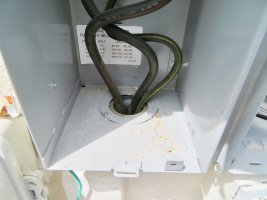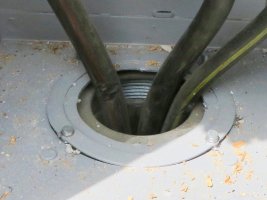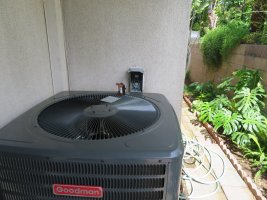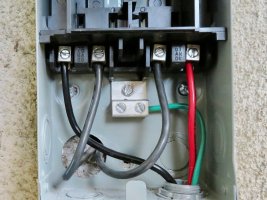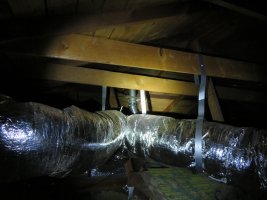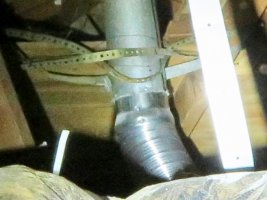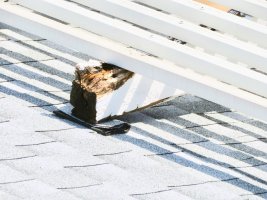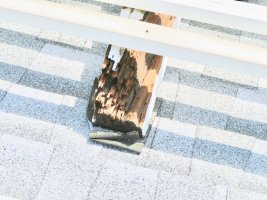-
Welcome to The Building Code Forum
Your premier resource for building code knowledge.
This forum remains free to the public thanks to the generous support of our Sawhorse Members and Corporate Sponsors. Their contributions help keep this community thriving and accessible.
Want enhanced access to expert discussions and exclusive features? Learn more about the benefits here.
Ready to upgrade? Log in and upgrade now.
You are using an out of date browser. It may not display this or other websites correctly.
You should upgrade or use an alternative browser.
You should upgrade or use an alternative browser.
An average day
- Thread starter ICE
- Start date
Question ... is the problem that they are using the wrong size? Doesnt look like it wraps far enough around the smaller wire. And i assume they are allowed by code, otherwise you would have (reluctantly) issued a citation.
Not sure i agree. Look at the raised panels in the top row ... the one on the left touches the header, the one on the right has a gap at the top.
linnrg
Sawhorse
Not sure i agree. Look at the raised panels in the top row ... the one on the left touches the header, the one on the right has a gap at the top.
That picture is just funny as hell I almost get dizzy just looking at it. Up here I have seen many of these issues due to frost heave. When I was a young guy I saw structural damage due to bentonite clay. Many of the builder's in my area used to bury trees and stumps on the lots which forever settle - so I have responded to lots of structural damage because of these bury pits.
The c-tap is too small. There is a specific tool that’s required for the crimping of the c-tap. That tool will emboss a number where it engages the copper. The number corresponds to a particular die for the specific c-tap. That didn’t happen and almost never does. Beyond all of that, this is a bare copper grounding electrode conductor to ground rods.....in a planter .....that requires protection from physical damage.Question ... is the problem that they are using the wrong size? Doesnt look like it wraps far enough around the smaller wire. And i assume they are allowed by code, otherwise you would have (reluctantly) issued a citation.
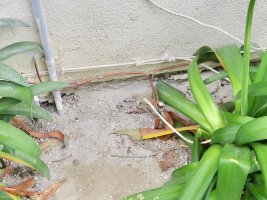
Last edited:
I put a ruler on the picture and they are too close to say otherwise. I saw the different reveal and wondered if it’s just the door.....everything looks like the day it was built but something is way off.Not sure i agree. Look at the raised panels in the top row ... the one on the left touches the header, the one on the right has a gap at the top.
my250r11
REGISTERED
If it's a #6 AWG GEC and free from physical damage the GEC can be run along the building surface without protection if secured. If not it would need protection, preferably in conduit.
I don't know the GEC size but assume that the GEC is a #6 AWG:
Question: Would you classify this install free from physical damage?
I don't know the GEC size but assume that the GEC is a #6 AWG:
Question: Would you classify this install free from physical damage?
Question: Would you classify this install free from physical damage?
No.
jar546
CBO
Your photos are amazing. I am going to assume that in order to get a license to do electrical work, you just need a business card?
A California contractors license is no indication of competence. There are businesses that prepare people to take the test for a license. It’s the same for inspector certifications.
Last edited:
TheCommish
SAWHORSE
OMW, I am not an electrical inspector and I can tell that is wrong
I hear inspectors saying that they do not go on roofs for inspections. The contractor for this job must have figured I was one of them as I had to ask for a ladder.


I'm no legal scholar but it seems to me that if a licensed contractor walked away from this he would bear a legal responsibility if it fell into the back yard. What the Hell, it's not attached at all.


I'm no legal scholar but it seems to me that if a licensed contractor walked away from this he would bear a legal responsibility if it fell into the back yard. What the Hell, it's not attached at all.
Attachments
Last edited:
conarb
REGISTERED
Tiger:
Who ties you off when you go onto roofs, do you carry your own gear? You wouldn't want to violate CalOSHA would you?
Who ties you off when you go onto roofs, do you carry your own gear? You wouldn't want to violate CalOSHA would you?
Inspector Gift
SAWHORSE
Give Tiger a break, Conarb. As you well know, the first guy up is never tied off.Tiger:
Who ties you off when you go onto roofs, do you carry your own gear? You wouldn't want to violate CalOSHA would you?
The only time that I have been tied off was in the delivery room.Tiger:
Who ties you off when you go onto roofs, do you carry your own gear? You wouldn't want to violate CalOSHA would you?
conarb
REGISTERED
A few years ago, I believe it was in Marin County, an inspector was on a roof and a contractor happened to drive by and see him, he turned him into CalOSHA and it made all the papers. If it was me I wouldn't have done that, I would have taken a picture with my cell phone, the next time Tiger came by one of my jobs and wrote my up I'd whip out my cell phone, show him the picture, and say: "Now Tiger you don't really want to write me up do you?"Give Tiger a break, Conarb. As you well know, the first guy up is never tied off.
I brought you this picture earlier. A correction was written to, "Provide 30"wide by 36" deep working space in front of the A/C disconnect.
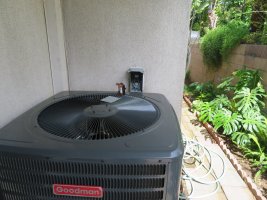
I was there today for the corrections. The condenser has been rotated 90°. The guy said that is what I told them to do.

I was dealing with a legitimate, licensed mechanical contractor. They have trucks and uniforms but not much else. I finally pointed out the service panel within reach of the condenser. I resisted doing that. I didn't want to do it....really I didn't. I was miffed that they can be so clueless yet take on these jobs. I gave in because they'll never get it if we don't teach them. That's a jacked up system.

I was there today for the corrections. The condenser has been rotated 90°. The guy said that is what I told them to do.

I was dealing with a legitimate, licensed mechanical contractor. They have trucks and uniforms but not much else. I finally pointed out the service panel within reach of the condenser. I resisted doing that. I didn't want to do it....really I didn't. I was miffed that they can be so clueless yet take on these jobs. I gave in because they'll never get it if we don't teach them. That's a jacked up system.
Last edited:
conarb
REGISTERED
Tiger, I don't know, isn't there a requirement that a condenser must be a certain distance from a window? Looks like the hot air is going to blow right back through that window.




